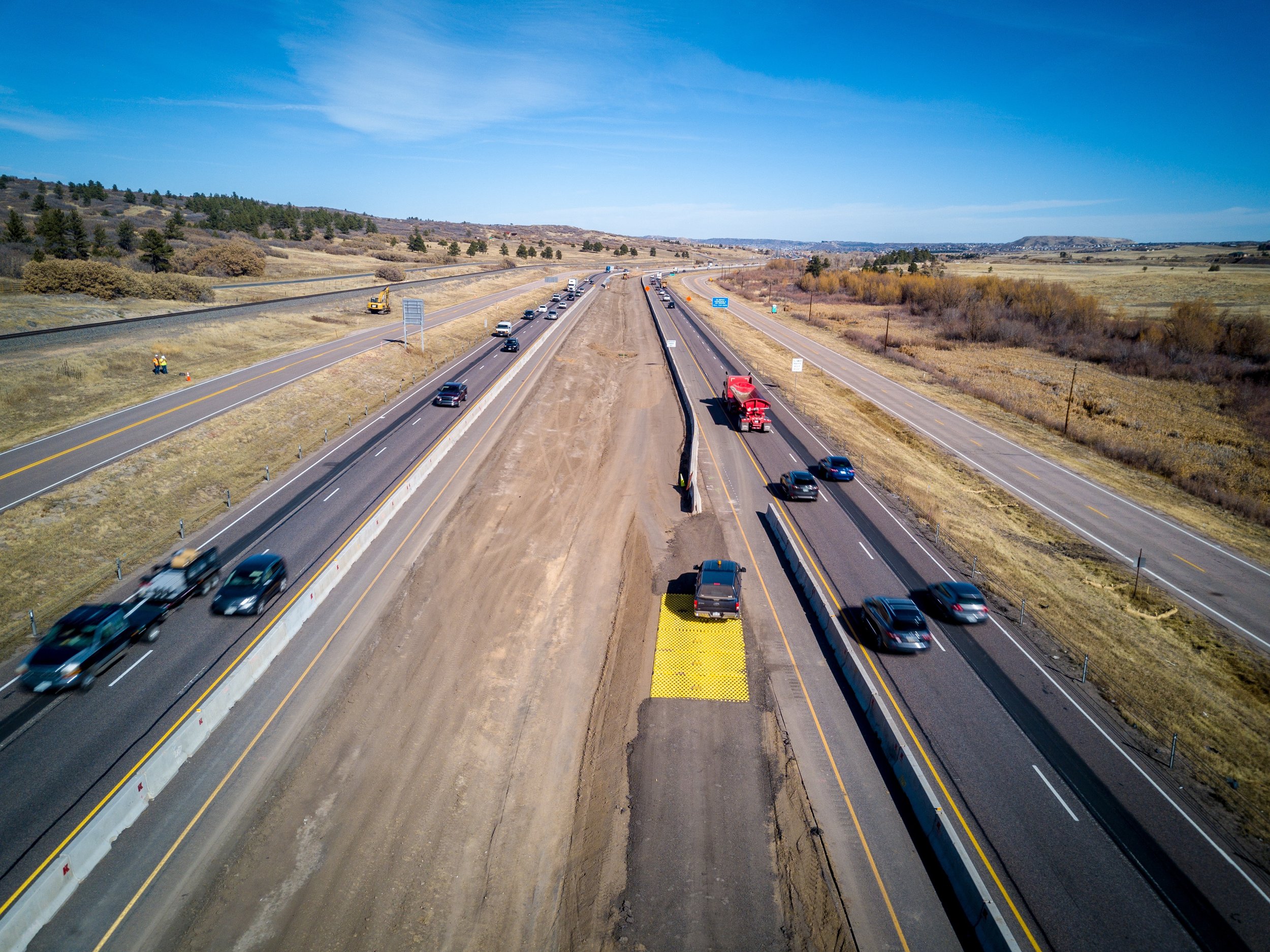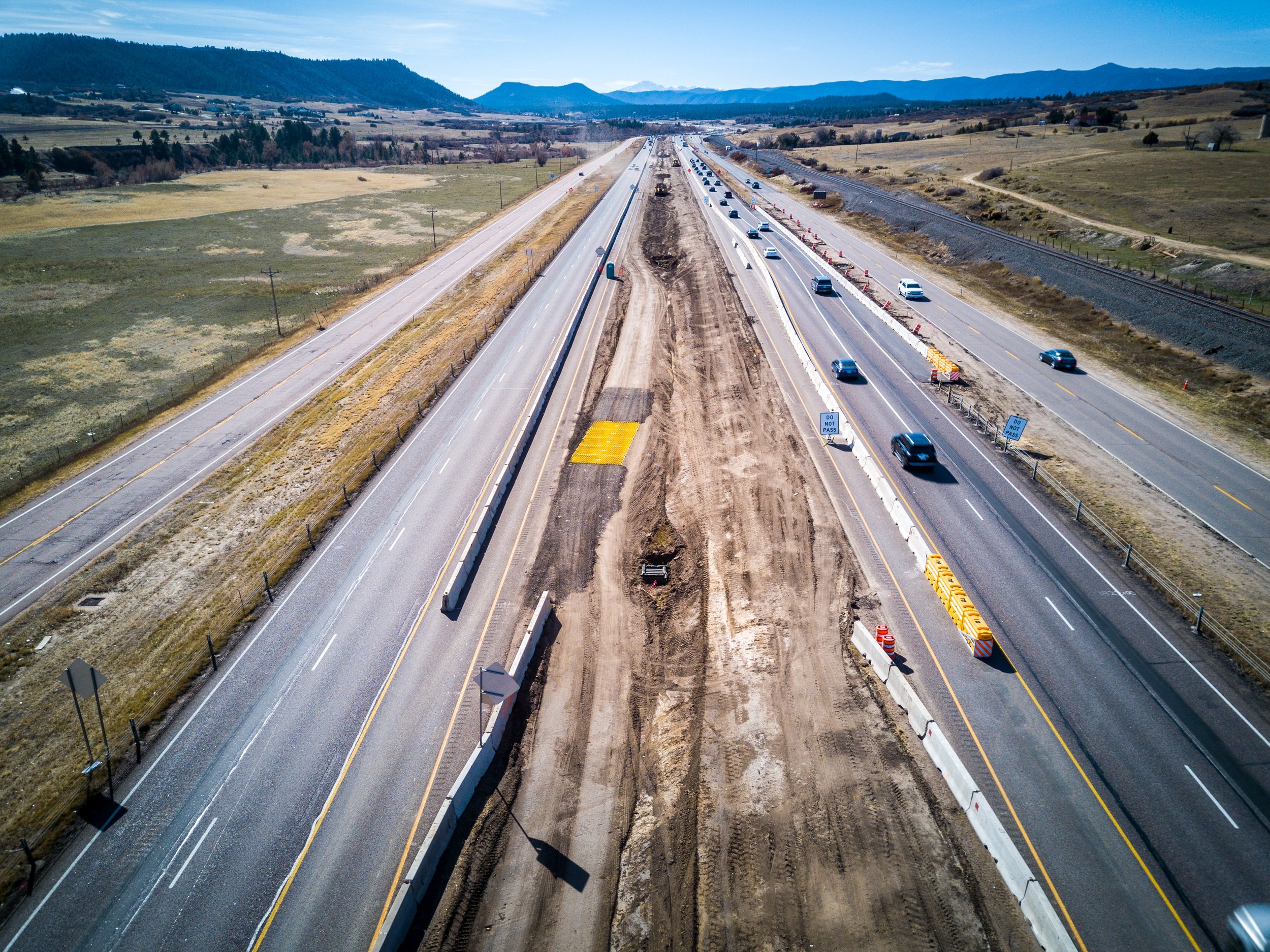FODS Deployed on I-25 South Gap Project
The I-25 South GAP Project: Colorado’s Longest Construction Zone
Interstate 25 is a major north-south interstate that runs through New Mexico, Colorado and Wyoming and is designated as a Congressional High Priority Corridor within the National Highway System. The I-25 highway connects Denver and cities and communities along the Front Range to the National Highway System.
Some segments of the interstate were constructed as far back as 1948, and have since undergone multiple expansions and lane additions to reduce accidents and delays and to provide capacity for the state’s growing population. On average, 87,000 motorists travel daily between two of Colorado’s largest cities, Denver and Colorado Springs, on the interstate running through Castle Rock and Monument. The Colorado Department of Transportation (CDOT) is currently adding express lanes both north and south of Denver through the GAP Project.
Map of the I-25 South GAP Project. CDOT
From Monument to Castle Rock Colorado
The South GAP Project is an 18-mile segment of Interstate 25, south from Castle Rock, Colorado, to Monument, Colorado. This stretch of the interstate was the only four-lane section of I-25.
After securing funds for the projects original scope, CDOT awarded the $419 million dollar Construction Manager/General Contractor (CM/GC) contract to Kraemer North America. Started in 1911, the national construction firm was chosen based on their experience and expertise in highway construction. The collaborative CM/GC contract enables engineers and project managers from both CDOT and Kraemer to work together from the design phase through to the end of construction.
The 18-mile South Gap project is split into three geographic sections – north, middle and south. Between September 2018 and Summer 2019, all three project sections began Phase I construction activities including median widening, earthwork and the construction of retaining walls. Phase II construction activity includes storm drain relocation, initial asphalt paving and guardrail installation. Final asphalt overlay, tolling infrastructure, pavement markings and signing would be completed during Phase III.
Highway underpasses are proven to reduce collisions protecting both wildlife and motorists.
The project will use over 822,000 tons of asphalt to resurface the eighteen mile stretch, widen shoulders, rebuild bridges, and add wildlife underpasses to the interstate. The added express lanes will provide reliable and shorter commute/travel times, reduce delays, manage congestion as the population continues to grow. The South GAP Project is expected to be complete in 2022.
Wildlife Habitat Considerations
The area surrounding the South GAP Project is the front range’s largest contiguous wildlife habitat and home to a large elk herd numbering between 1500 to 2000. As state population increases, more pressure is placed on the habitats which support the natural ecosystem. In efforts to protect the elk herd and preserve the wildlife habitat, CDOT in conjunction with Colorado Parks and Recreations, Castle Rock, Castle Pines, and Douglas County is constructing four new wildlife underpasses, restoring one existing underpass. In addition, the 28 miles of wildlife fencing will be installed along the highway to direct wildlife towards the underpasses. The wildlife underpasses will decrease wildlife collisions and maintain the herd’s current population.
Highway Construction Requirements
FODS Mats Installed to reduce sediment tracking onto the active I-25 lanes. The 1x5 configuration pictured is specified by the CDOT handbook. Learn More.
One of the biggest challenges involved with keeping the longest construction zone in the state running smoothly is to keep traffic flowing while maintaining safety and mobility. Any reductions in construction traffic would help to reduce congestion on the active lanes. Maintaining safe road conditions also requires that any debris is captured before it can be tracked by construction vehicles onto the active highway lanes.
Lanes had to be diverted or narrowed and shoulders were non-existent in sections throughout the project. Staging areas were located off exits, but other equipment and vehicles were stored in the median. Kraemer needed a way to allow heavy equipment easy on and off access to the construction site while widening the median. Additionally, high speeds plus construction debris can cause dust and hazardous projectiles to passing motorists.
Soils from the project contain impermeable clay and stormwater events cause erosion to exposed areas. In order to maintain environmental compliance and provide stormwater management to the surrounding wildlife habitat during construction, dust needs to be minimized and construction debris and trackout needs to be kept on-site.
CDOT Erosion Control & Stormwater Quality Guide
CDOT highway construction projects authorized under a unified stormwater permit for which utilizes techniques in the Departments’ Erosion Control & Stormwater Quality Guide for mitigating and minimizing erosion and sedimentation. The Guide includes techniques for stabilizing disturbed areas and includes various techniques for stabilizing construction entrances during operations.
FODS Modern Reusable Manufactured Vehicle Tracking Pad
Kraemer North America chose the CDOT approved FODS Trackout Control Mats to use for the construction entrance BMP on this project. FODS were selected because they can be quickly deployed and relocated throughout the project, allowing Kraemer North America to reuse the system during each phase as needed. In order to allow easy access to the construction site, trackout control mats were installed along the interstate. FODS Reusable compact construction entrances allowed heavy equipment vehicles to enter and exit the interstate while minimizing the amount of sediment leaving the site causing
The FODS mats along Interstate 25, measure 12’ wide by 7’ long and can be installed on both dirt and paved surfaces in under 30 minutes. The mats contain pyramids that work to loosen sediment and debris as vehicles pass over the top inch of the pyramids. FODS trackout control systems are easy to install, relocate, transport, and reuse. Each trackout mat can withstand 80 tons of weight and has an expected lifespan of ten years plus.
As the project progressed, multiple compact FODS vehicle tracking systems are being used for Kraemer North America’s construction equipment that mitigated construction site trackout. FODS Trackout Control Mats provided Kraemer North America with an expedited installation entrance and safer vehicle tracking pad while eliminating sediment displacement on the interstate.
For easy maintenance of the FODS systems throughout the project, Kraemer uses a FODS shovel to clean and reuse the mats.
For highway project operators are responsible to minimize sediment tracking at each point of egress. Because highway projects progress linearly, operators may be required to established hundreds of entrances throughout construction. CDOT specifies a 1x5 configuration of FODS Reusable Manufactured Vehicle Tracking Pad as an alternative to the traditional gravel style vehicle tracking pads. When used on highway projects, the FODS system, can significantly reduce costs as the mats can be relocated and reused over and over. In addition, the mats do not introduce aggregate which can be tracked onto the active lanes causing hazards for motorists.
Kraemer project has over 100 mats in use concurrently over the three sections of work to create over 20 entrances which can be deployed wherever needed.
ABOUT FODS, LLC.
Based in Englewood Colorado, FODS Trackout Control System replace ineffective and costly traditional rock stabilized construction entrances, saving you time and money. Our proprietary mat design works to effectively remove debris from your vehicle tires without damaging the tire or the ground’s surface. We provide the only durable, reusable, and environmentally friendly trackout control system currently available on the market. FODS Reusable Construction Entrances are 100% Made In the USA and 100% recyclable.
To find out more information on how we can help your project stay on schedule and in compliance contact 844-200-3637 or email us at info@getfods.com.






